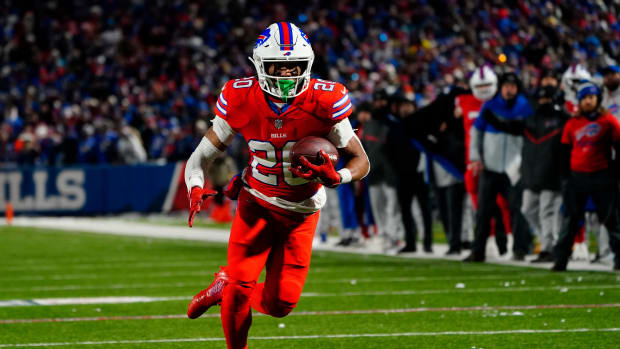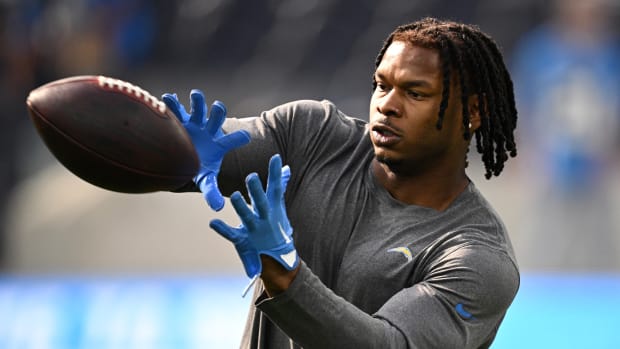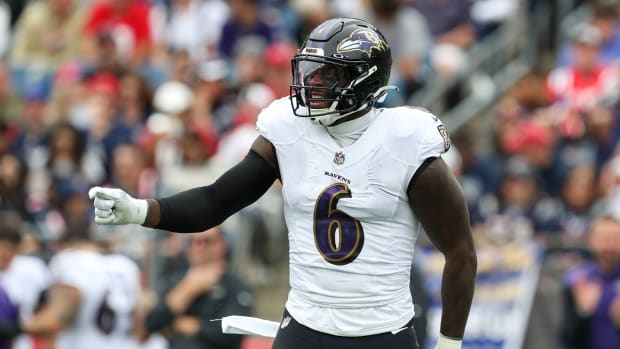
Can’t Catch a Break from Canton
By Andrew Lawrence
Tim Brown does not answer calls from numbers he does not recognize. When such a number, bearing a 330 area code, flashed on his phone four winters ago, he cycled through the usual screening checks. The call wasn’t from Dallas, where he grew up and lives now. It wasn’t from South Bend, where he penetrated the national consciousness as a Heisman-winning receiver and returner at Notre Dame. And it wasn’t from California, where he spent the bulk of his 17-year NFL career braving certain harm inside the hash marks as an L.A. and Oakland Raider. So on to voicemail it went and remained, forgotten.
Until later that day, that is, when Brown turned on the television and saw his name among the 15 finalists for the Pro Football Hall of Fame’s 2010 class. Suddenly it clicked: That was Canton, Ohio, calling. He redialed and was quickly intoxicated by the optimism that greeted him on the other end. The closer he got to D-day, the more inevitable his enshrinement was made out to him.
Smash cut to a month later, the Saturday before Super Bowl XLIV in South Florida. Brown is in Fort Lauderdale, driving down the freeway to an event that will feature current Hall of Famers and the newly inducted, when his rep calls to tell him he didn’t make the cut. Only Jerry Rice had made it in among the four wide receiver finalists. The snub stung like hell, but he could track the logic. Who would argue that Rice wasn’t one of the greatest ever?
Cris Carter could once identify with Tim Brown's dismay, until he broke through the Hall of Fame logjam this year. (Stacy Revere/Getty Images :: Al Tielemans/SI)
Brown, who caught 1,094 passes for 14,934 yards and 100 touchdowns in 255 games, tried not to take it personally. He adjusted his optimism for 2011, when he might hear his name announced against the backdrop of a Super Bowl being played in his hometown of Dallas. The Hall, he reckoned, wanted him to be home so he could celebrate his crowning achievement with family and friends. And that’s exactly where he was—in front of the TV, again—when he learned that no receivers had made the cut that year.
This is when Brown started to lose it. How, he wondered, could Canton declare a moratorium on wideouts? The waiting list was long, and the names at the front were illustrious. Ever since he became eligible for induction in 2009, five years after his retirement, he had been locked in a perpetual logjam with the Vikings’ Cris Carter, who ranked second in career receptions (1,104) and touchdowns (130) at the time of his retirement after the 2002 season; and the Bills’ Andre Reed, a four-time Super Bowl participant who hung up his cleats after 2000 and had been one half of the most productive quarterback-receiver tandem in history. And yet, no Hall passes. Not one. Not in 2011. Not in 2012. The whole morass left Brown heartbroken and numb.
If there was a silver-and-black lining for Brown, it was that at least two other people on earth understood exactly what he was going through. He found comfort in commiserating with Carter and Reed. It doesn’t matter which one of us gets in first, the men would say to one another. And when the Hall called Carter to its roster this winter—he will be formally inducted in Canton on Saturday—everyone stayed true to the script. It hasn’t been easy, though. “I just saw Cris a week or so ago, and I hugged that brother and said, ‘Congratulations, I’m happy for you,’ ” says Brown, 47. “And I truly am happy for him. But as happy as you are for him, you’re sad for yourself.”
* * *
A receiver is the only one of football’s characters who lacks true agency. A tailback can blaze his own path; a receiver’s is predetermined. A quarterback charts the course of a team. The linemen produce the whole show. A receiver can’t do much until the others have had their say. He needs to be enabled. That takes time. A receiver defies time. Give him 4.3 seconds and he’ll erase 59 minutes. He’ll break the game open; it happens too many times to count. And yet for as high as his potential impact is, it remains locked in inverse proportion to his free will. The more he dials up his confidence to protect himself from the frustration that comes with being powerless, the more that confidence is dismissed as egotism or, worse, a false sense of entitlement. The team can win but he cannot, because a receiver cannot define himself.
Football is, fundamentally, a show about offense. (Occasionally, the players on the other side of the ball steal a scene or two.) The Hall of Fame reminds us why we can’t stop watching. The pass draws us into the game. But the catch is what holds our attention, what we replay, what we retweet. In the modern-era the Hall of Fame has inducted 21 receivers, a cohort that trails only offensive linemen (39), tailbacks (28) and quarterbacks (23) in number. And if you think that’s fair, you are kidding yourself. You are not watching football in this day and age. Because if you were, and you populated a list of potential Hall of Famers with contemporary players, the receivers would come out on top. Just because many men play that position doesn’t mean that there can’t also be a lot of them who are very good at it.
The fantasy market understands that there can be quality in quantity. (See: Cruz, Victor, 2011 waiver wire MVP.) But, more importantly, so does the free market. It recognizes the value of a receiver—the 2013 franchise number for wide receivers, $10.537 million, is second highest among offensive positions behind the quarterback. But that’s because the free market is set by football people, or more specifically, as former Colts GM Bill Polian calls them, “people who deal with the minutiae of football for a living.” These people do not select who goes into the Hall of Fame. Journalists do. People like me. (But not me specifically.)
And though the conversation about potential Hall of Fame members is ongoing, selection committee members meet as a body only once a year, during Super Bowl week, to hear arguments. “The meeting is the culmination of a lot of prior meetings and a lot of formal meetings,” says Hall spokesman Joe Horrigan, who supervises the process. “And then it is a continuation of the year before. I always warn new selectors, ‘Don’t be thrown by the fact that we might not speak as much or as thoroughly about a candidate as you think should be, because that candidate has probably already been discussed in this same room by the same people for the last five years, and they all know what’s been said.' ” The keys to victory in the jury room? Make it dynamic, and keep it short. “Some people get mad when the meeting goes more than three hours,” says Don Pierson, an ex-voter and former Chicago Tribune writer. “That’s another flaw in the system.”
The pass draws us into the game. But the catch is what holds our attention, what we replay, what we retweet.
But before you go blaming the media for the Hall’s perceived fumblings, consider the football people’s role in this. They handed off this power, and they didn’t always have a firm handle on it either. When the Hall opened its doors in 1963, pro football was in its fifth decade. The line to get into Canton stretched to Pittsburgh, and football men like the Bears’ George Halas and the Giants’ Wellington Mara worked the velvet rope. Not surprisingly, the biggest celebrities got in first, which is understandable. The word fame is right there on the front door, after all. Hence you have Red Grange, an average defensive back with the Bears and Yankees, making the inaugural class largely on his reputation as the celeb student-athlete at Illinois; and Bob Waterfield, a 50% passer whose single-season touchdowns exceeded his picks only once in his eight-year career, getting a Hall pass in ’65 possibly because he had the good sense to wife up Jane Russell, the Megan Fox of her day.
Andre Reed’s 951 receptions are 11th alltime—though he’ll be pushed lower as the current crop continues to pile up the catches. (John Biever/SI)
Since then the selection approach has become more objective. But objectivity only gets you so far in the modern-day game, which is in the middle of a statistical boom. The last decade alone has seen major rules changes to facilitate passing and scoring. Receivers are thriving now, but their many 90-catch, 1,000-yard seasons are only going to make them tougher to judge in the future. Case in point: Of the 76 100-catch seasons in history, only three came before 1990: Lionel Taylor (106) for the Broncos in 1961, Charley Hennigan (101) with the Oilers in 1964 and Art Monk (106) for the Redskins in 1984. And while it’s true that the move from 14 to 16 games in 1978 helped boost season totals, today’s per-game numbers are historically unprecedented.
Of the 14 players alltime who have averaged more than five receptions per game (minimum 200 receptions), 10 are active and only one, Sterling Sharpe, did not play into the 2000s. By that standard, Wes Welker is the most prolific pass-catcher in history, at 6.1 receptions per game. Yardage numbers are equally illuminating: Sixteen players have averaged more than 70 receiving yards per game (with at least 200 career catches); only three—AFL stars Hennigan, Art Powell and Lance Alworth—did not play in the ’90s or 2000s. Calvin Johnson of the Lions is the alltime leader, at 85.2 yards per game; Torry Holt, a name not often mentioned in Canton discussions, is third at 77.4.
Such numbers leave room for selectors to wonder: Is it the receiver, the quarterback, or (shudder) the system? “I heard that one of the negatives about us is that we came up in a passing era,” Brown says of himself, Carter and Reed. “And I’m like, ‘If we’re in a passing era, then what the heck are you calling this?’ ”
The game is so wide open now that even a tight end can reasonably expect to catch upward of 60 balls a season. The 2011 Hall of Fame class—which, while receiverless, included hybrid pass-catchers Shannon Sharpe (a tight end), Marshall Faulk (a tailback) and Deion Sanders (a cornerback)—seemed more like a harbinger than a fluke. “Should we throw out the terms wide and tight and just make it ends?” wonders The Dallas Morning News’ Rick Gosslein, a longtime Hall of Fame voter. “Pass-catchers? What [Rob] Gronkowski and [Tony] Gonzalez are doing is putting up wide receiver numbers.”
And the more voters parse those numbers, it seems, the more excuses they come up with not to pick a player. In essence, they morph into the very people whose decisions they second-guess for a living: the football people.
Can’t Catch a Break from Canton
CANTON’S WATCHING Andre Johnson, Texans, age 32. Second alltime in receiving yards per game at 81.6. Injuries seem the only thing that might slow him. (Damian Strohmeyer for Sports Illustrated)
CANTON’S WATCHING Anquan Boldin, 49ers, age 32. The fastest player in history to reach 600 receptions—he did it in 98 games. Numbers dropped a bit in Baltimore but should pick up out West. (Simon Bruty/SI)
CANTON’S WATCHING Brandon Marshall. Bears, age 29. His 118 catches last season are tied for 10th alltime. Mercurial but productive paired with Jay Cutler. (Al Tielemans/SI)
CANTON’S WATCHING Calvin Johnson, Lions, age 27. Had a monster 2012—122 catches for an NFL record 1,964 receiving yards; 2K is the goal for 2013. (John Biever/SI)
CANTON’S WATCHING Larry Fitzgerald, Cardinals, age 29. Pro’s pro keeps on producing the specatular despite the QB and coordinator carousel in Arizona. (John W. McDonough/SI)
CANTON’S WATCHING Randy Moss, free agent, age 36. A Canton lock despite a personality that rubs some the wrong way. Second alltime in touchdown catches, with 156. (Lou Capozzola/SI)
CANTON’S WATCHING Reggie Wayne, Colts, age 34. 968 receptions. Luck be with him—his 106 catches and 1,355 yards in 2012 were second-most in his 12 seasons. (Peter Read Miller/SI)
CANTON’S WATCHING Steve Smith, Panthers, age 34. Smith’s consistent, averaging 77 catches over the last eight seasons. Three more like that and he’ll reach 1,000. (David E. Klutho/SI)
CANTON’S WATCHING Wes Welker, Broncos, age 32. He’s less than halfway to Rice’s 1,549 but seems made to catch passes from Peyton Manning. (Damian Strohmeyer for Sports Illustrated)
* * *
The relevant question in the Hall of Fame discussion should be this: If you had to write the story of the league during a player’s time, could you leave him out? It’s the question that cuts through the confusion that comes with comparing players of different positions and discourages comparisons across eras. It’s the one question that rules all the others—about production, about value, about taste.
That question practically edits the Canton waiting is by itself. Offensive linemen? They had a good run. “I think there are some people who have gotten in on reputation and not really on dominance,” Polian says. “The fact of the matter is, all the great ones are in.” Ditto for eligible tight ends, unless an intrepid Eagles fan goes back in time and tells coaches to not to move the 6-8 Harold Carmichael (who’d go on to score on 13% of his catches) from tight end to wideout. Quarterback? There’s the Raiders’ Kenny Stabler (and maybe Cincy’s Ken Anderson), and then there’s everyone else.
Receivers? They could go in two at a time, with the eligibility of the tandem hinging on the player who retired most recently. They could go in by category: The Deep-Ball Pioneers (the Raiders’ Cliff Branch and Dallas’s Drew Pearson), The Do-It-All Winners (the Broncos’ Rod Smith and the Steelers’ Hines Ward), The Go-To-Guys (the Colts’ Marvin Harrison and the Rams’ Isaac Bruce), The Other Guys (the Colts’ Reggie Wayne and the Rams’ Torry Holt), The Problem Guys (Terrell Owens, Randy Moss).
Isaac Bruce, Marvin Harrison, Terrell Owens and Hines Ward—the other four retired receivers to join Tim Brown and Cris Carter with 1,000 receptions—are only going to make the receiver logjam worse in future years. (Peter Read Miller/SI :: Bill Frakes/SI :: Heinz Kluetmeier/SI :: John Biever/SI)
And then of course, there are The Forsaken: Reed and Brown. Reed has been a finalist in each of the last seven years. Every year that he seems poised to cross the threshold, he gets flagged for losing four Super Bowls. Never mind that his quarterback and running back already have bronze busts in their likeness and that the no-huddle offense he helped electrify is practically a league staple now.
“People keep telling me, ‘He’ll get in. He’ll get in. Just be patient,’ ” says Polian, the architect of those great Bills teams. “And then this year it was, ‘His numbers don’t measure up.’ Measure up to what? If you measure his numbers against everybody who played in his time, he’s as good or better than anybody. I don’t get it. It’s beyond me. I just can’t figure out why. I don’t know why. No one can give me a logical answer. I ask, and the answers that I get … when you apply metrics, when you apply logic, it just doesn’t seem to work out.”
* * *
Once teammates, Tim Brown is waiting to re-join Jerry Rice in the Hall of Fame. (Walter Iooss Jr./SI)
If things ever do work out for Brown, if his nine Pro Bowl nods, his fifth-place rankings in all-purpose yards (19,679) and receiving yards, and his 100 touchdown catches (from 11 different QBs) ever put him over the top, it’ll be a bittersweet day. The people he hoped to share that moment with are starting to die off. In 2011 he lost his father—his biggest fan in public and harshest critic in private. Five months later Al Davis, another fan/critic, passed. A month after that, his best friend and longtime Raiders teammate, Chester McGlockton, died of an enlarged heart at just 42.
And then, five months later—Junior Seau. “We had great, real respect for each other,” Brown says of the late linebacker, a perennial menace to him in the Raiders’ frequent AFC West clashes with Seau’s Chargers. “He used to tell me, ‘Brown, when you line up in the slot, we’ve got four people looking at you. And depending on which way you release, they’re gonna keep looking at you.’ ” Off the field, though, the tone was more civil. “We’d play in each other’s golf tournaments. We used to do things together at Pro Bowls. He was just one of those guys that if I ever went to San Diego I knew I had a place to stay, somebody to hang out with, no questions asked.”
What Brown would give to return to a time when people didn’t question him. His four kids want to know why one man can accomplish so much and even more men can minimize it. Is there more control he can exert over his destiny, a campaign he can wage? No. He is resigned to the situation. He’s gotten used to waiting. This is what a receiver signs up for, after all. “I keep saying there’s nothing more I can do,” says Brown, who will sidestep coverage of the induction ceremony for the fourth straight year. “I can’t catch any more balls. I can’t return any more punts. I am totally waiting on other folks to make this happen for me.”
In other words he’s merely playing his position. Give the guy credit for mastering it.


















































